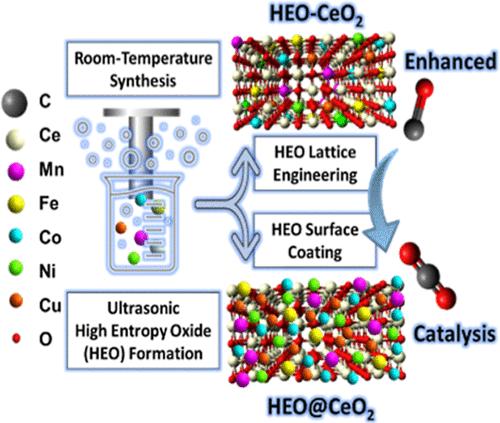环境条件下高熵氧化物的精密结构工程
IF 11.3
1区 化学
Q1 CHEMISTRY, PHYSICAL
引用次数: 0
摘要
高熵氧化物(HEOs)在异相催化领域开辟了一个独特的前沿领域,它利用熵效应和更高的复杂性提供了超高的稳定性和巨大的调节能力。然而,目前的 HEO 合成主要依赖于高温退火方法,因此 HEO 没有表面积或表面积较小,活性位点暴露效率较低,结构调整的可控性较差。如何生产出具有高活性位点利用效率的高质量 HEO 催化剂是一大挑战,而这有赖于精密的结构工程,最好是在温和条件下进行。本研究开发了一种原位晶格工程方法,可在环境条件下制备支撑型 HEO 催化剂。通过超声波产生的空化诱导成核作用,将 HEO 成分(CuCoFeNiMnOx)均匀地整合到 CeO2 的晶格中。所获得的催化剂具有高比表面积、原子分散的 HEO 成分、活跃的氧化还原特性、丰富的氧空位 (OV)、抗团聚以及在苛刻条件下的高相稳定性等特点。与在表面原位引入 HEO 相比,原位法具有双重优势,即通过熵效应和晶格约束效应保持 HEO 的分散性。在萤石结构 CeO2 的晶格内设计复杂的 HEO 还能产生丰富的缺陷(如 OV)和具有强还原性的活性金属位点(如 Ce3+ 和 Cu+),这大大提高了晶格氧的活性和客体分子吸附行为的可调性,尤其是在存在杂质(如水和丙烷)的情况下。支撑型 HEO 催化剂在氧化过程中的催化性能超过了纯致密相 HEO 以及原位生成的催化剂。这项工作中开发的合成方法以及对结构演化和反应机理的基本理解,展示了在环境条件下生成稳定催化剂的便捷途径,这种催化剂能够在高温条件下保持结构的稳健性,同时提供更高的催化性能。本文章由计算机程序翻译,如有差异,请以英文原文为准。

Precision Structure Engineering of High-Entropy Oxides under Ambient Conditions
High-entropy oxides (HEOs) have unveiled a unique frontier in the realm of heterogeneous catalysis, taking advantage of the entropic effect and increased complexities to deliver ultrahigh stability and large tuning capability. However, current HEO synthesis mainly relies on high-temperature annealing approaches affording HEOs possessing no or low surface area, inferior active site exposure efficiency, and low controllability over the structure tuning. The grand challenge lies in producing high-quality HEO catalysts with high active site utilization efficiency, which relies on precision structure engineering, preferably under mild conditions. In this work, an in situ lattice engineering approach was developed to afford a supported HEO catalyst under ambient conditions. The HEO compositions (CuCoFeNiMnOx) were uniformly integrated into the lattice of CeO2 driven by cavitation-induced nucleation being generated via ultrasonication. The as-afforded catalysts were featured by high surface area, atomically dispersed HEO compositions, active redox properties, abundant oxygen vacancies (OV), antiagglomeration, and high phase stability under harsh conditions. Compared with the ex situ introduction of HEO on the surface, the in situ method provides dual benefits to maintain the dispersity of HEO via entropic and lattice confinement effects. Engineering the complex HEO within the lattice of fluorite-structured CeO2 also yields abundant defects (e.g., OV) and active metal sites with strong reducing properties (e.g., Ce3+ and Cu+), which greatly improves the activity of the lattice oxygen and tunability of the adsorption behavior of the guest molecules, especially in the presence of impurities (e.g., water and propane). The catalytic performance of the supported HEO catalyst in oxidative procedures surpasses the pure dense phase HEO as well as the ex situ-generated catalysts. The synthesis approach being developed in this work, together with the fundamental understanding in structure evolution and reaction mechanism, showcases a facile pathway under ambient conditions to generate stable catalysts capable of maintaining structural robustness in high-temperature conditions while delivering enhanced catalytic performance.
求助全文
通过发布文献求助,成功后即可免费获取论文全文。
去求助
来源期刊

ACS Catalysis
CHEMISTRY, PHYSICAL-
CiteScore
20.80
自引率
6.20%
发文量
1253
审稿时长
1.5 months
期刊介绍:
ACS Catalysis is an esteemed journal that publishes original research in the fields of heterogeneous catalysis, molecular catalysis, and biocatalysis. It offers broad coverage across diverse areas such as life sciences, organometallics and synthesis, photochemistry and electrochemistry, drug discovery and synthesis, materials science, environmental protection, polymer discovery and synthesis, and energy and fuels.
The scope of the journal is to showcase innovative work in various aspects of catalysis. This includes new reactions and novel synthetic approaches utilizing known catalysts, the discovery or modification of new catalysts, elucidation of catalytic mechanisms through cutting-edge investigations, practical enhancements of existing processes, as well as conceptual advances in the field. Contributions to ACS Catalysis can encompass both experimental and theoretical research focused on catalytic molecules, macromolecules, and materials that exhibit catalytic turnover.
 求助内容:
求助内容: 应助结果提醒方式:
应助结果提醒方式:


